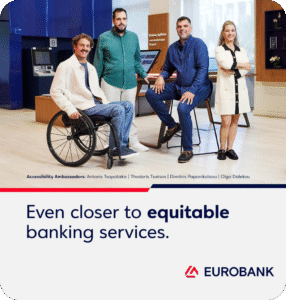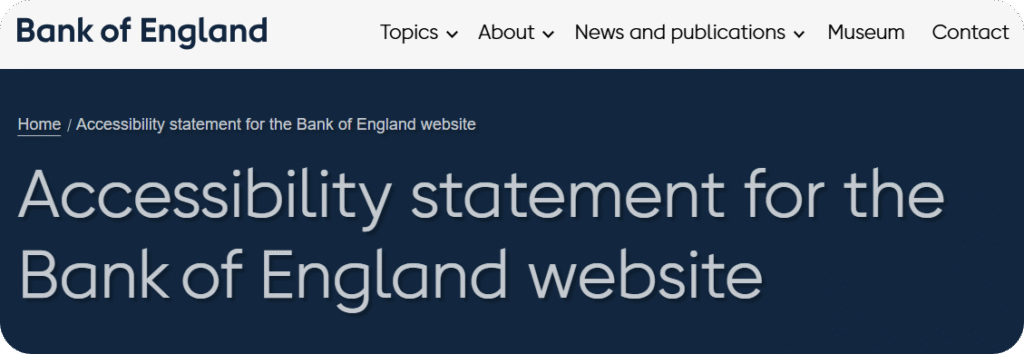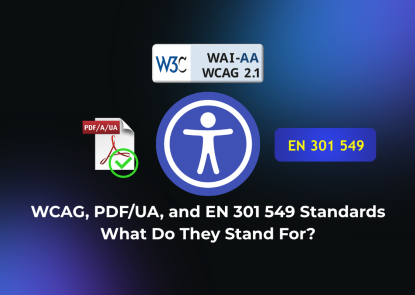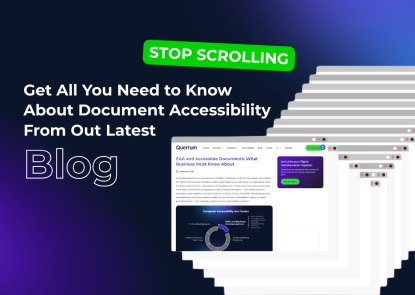EAA Compliance Examples: European Banks Accessibility Cases
November 6, 2025

Living in the business world, we are getting used to seeing the opportunities, when most people have no attention to. This is a great ability, which helps not only earn but also make our life better.
In the World Health Organization (WHO) European Region, an estimated 90 million people have vision impairment or blindness and 190 million have hearing loss or deafness.
We collected some great examples of companies, which managed to treat Accessibility as an opportunity and got not only better ROI, but earned trust.
Now people with impairments can use the service of the next companies and live their best life. They can buy a ticket, hear the banking statement and monitor the usage clearly with utility service bills.
Points of Development for Banking Leaders: Observing the Demand to Fill It In
Despite growing regulation and awareness, the majority of digital services and documents remain inaccessible to people with disabilities. The WebAIM Million study (2025) found that 95% of the world’s top websites contained detectable WCAG 2 failures, highlighting how pervasive accessibility gaps remain – even among large and regulated companies that are expected to lead by example.
The issue extends beyond websites. In academia, where digital publications should be a cornerstone of inclusive knowledge sharing, the situation is equally problematic. Kumar and Wang (2024) examined scholarly PDFs published between 2014 and 2023 and found that fewer than 3.2% met basic accessibility standards such as tagging, alternative text, language metadata, and structured tables. This neglect reflects a broader trend across industries: documents, though widely used for contracts, policies, billing, and customer communications, are rarely designed with accessibility in mind.
Even with accessible websites, PDFs remain a weak link in the compliance chain. However, the reality is that many companies still struggle with both – non-compliant websites and inaccessible documents often coexist, and either can trigger enforcement. Most companies don’t realise how many critical documents (onboarding, billing, contracts) fall outside centralised systems and therefore skip routine audits.
The institutions below recognized this reality and took action. Their implementations offer practical roadmaps for organizations still planning their compliance strategies.
Case #1: Eurobank (Greece) – Comprehensive EAA Alignment
Not every bank has created a document that officially recognises their accessibility gaps and development plans. Eurobank deserves recognition for this transparency—they’ve formally aligned their accessibility strategy with the European Accessibility Act through Greek Law 4994/2022, publishing a comprehensive public statement that most competitors avoid.

What They’re Doing
In their 2025 accessibility statement, Eurobank commits to making all services and channels, including digital content like “files in PDF format”, accessible and comply with EN 301 549:2021 and WCAG 2.1 AA standards. This means customer-facing PDFs (forms, statements, brochures, account documents) are being updated to meet technical accessibility requirements.
Eurobank emphasizes that accessibility is both a legal obligation and “a fundamental expression of respect, inclusion, and customer-centred service.” The bank’s digital channels are currently partially compliant and undergoing continuous improvements toward full accessibility.
Strategic Approach
Rather than treating accessibility as a one-time project, Eurobank frames it as core to their customer experience strategy. This positioning signals to customers, regulators, investors that accessibility improvements are sustainable, not superficial.
Case #2: Bank of England (UK) – Public Sector Leadership
As a public-sector entity, the Bank of England follows UK accessibility regulations, requiring all new content meet WCAG standards.

What They’re doing
The Bank’s accessibility statement notes they “strive to make any new PDFs and Word documents we publish meet accessibility standards.” In practice, newly published reports, consultation papers, and policy documents are designed for assistive technology compatibility, tagged PDFs with alternative text, proper reading order, and semantic structure.
Legacy documents (pre-2018) may not all be remediated, but accessible versions are provided upon request. This pragmatic approach acknowledges resource constraints while ensuring ongoing compliance for new publications.
Strategic Approach
The Bank of England adopted an “accessibility by default” policy for new documents rather than attempting to retroactively fix decades of archives. This forward-looking strategy prevents accumulation of new accessibility debt while managing legacy content requests case-by-case.
Case #3: Honda Bank GmbH (Germany) – Forward-Looking Compliance
Honda’s finance arm in Germany issued an accessibility (Barrierefreiheit) statement aligned with the EAA under German law (Barrierefreiheitsstärkungsgesetz – BFSG).
What They’re Doing
Honda Bank acknowledges that some PDFs on its website currently lack accessibility features (missing tags, insufficient alt-text). However, the bank “plans to design future PDF documents to be barrier-free, in order to meet the required standards.”
All newly generated PDFs for customers—product information, account documents, contract terms—will be created to PDF/UA and WCAG specifications before the June 2025 enforcement deadline.
Strategic Approach
Honda Bank’s transparency about current gaps paired with concrete remediation timelines demonstrates regulatory compliance without overpromising. By focusing on template-level changes for future document generation, they can build scalable accessibility into their customer communication workflows rather than pursuing expensive per-document fixes.
For the financial industry, these cases signal a clear shift from one-off document fixes to systematic, scalable accessibility management. This transparency shows that real compliance depends on embedding accessibility into every customer communication template, not just polishing a few visible reports.
Opportunities in Numbers
These implementations aren’t just regulatory responses, they unlock measurable business opportunities. Approximately 24% of the EU population lives with some form of disability. By providing accessible PDFs and digital services, banks can serve this demographic that competitors are neglecting. For context, UK households with disabled members control £274 billion in annual spending power. Banks and building societies lose an estimated £935 million monthly by maintaining accessibility barriers that drive these customers away.
Where to Start Your PDF Accessibility Implementation Journey
The institutions above share common implementation patterns your compliance team can replicate:
1. Conduct Honest Accessibility Audits: Don’t assume website compliance means document compliance. Most organisations have accessible web properties but inaccessible PDFs in contracts, onboarding, billing, and customer communications outside centralised systems.
2. Prioritise Template-Level Fixes: Following Honda Bank and Bank of England’s model, focus on making new document templates accessible rather than remediating entire archives. One compliant CCM template generates thousands of accessible outputs—precisely what banks and enterprises need at scale.
3. Document Your Progress Publicly: Like Eurobank, publish accessibility statements with specific standards and timelines. Transparency builds trust with customers and demonstrates good faith to regulators.
Here we broke in our article PDF Accessibility and EAA: Guide for Compliance, where you can find you need to know where you start to document accessibility strategy and how to lead this process painlessly.
Ready to start your accessibility journey? Learn more about PDF accessibility requirements or request a free PDF audit to identify gaps in your customer communications before regulators do.
Bonus Case: Easy Jet and Accessible Application
EasyJet, British multinational low-cost airline and package holiday group, builds reliable customer experience while taking maximum from the market. In this short case, we welcome you to immerse yourself in the world of people with visual impairments and discover the principles of accessible customer experience in less than 5 minutes.
Our simple question: Have you ever tried to book a flight with closed eyes?
This sounds like a real challenge, but anyway EasyJet gets things solid, and lets people actually book the flight just with the voiceover. In this short video, you can try these shoes and understand the approach of accessibility better.
Comparing the service of Ryanair, Jet2 and Tui, Adi Latif, the well-known accessibility consultant, is booking a flight to Alicante, Spain. With no loud market data or buzzwords, but with real usage he showcased the ease of use of the EasyJet application for people with visual impairments.
This real-world example gave approximately 340,000 people with vision impairments a comfortable way to travel, whilst opening the door to market dominance among people with impairments. EasyJet proves that accessible customer experiences aren’t just compliant —they’re competitive advantages.
Let’s drive your Digital Transformation Together.
Schedule a free consultation with our team to explore how we can help you achieve your goals.


